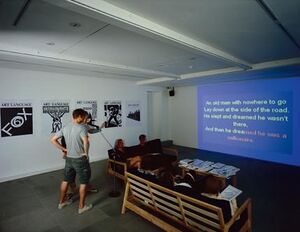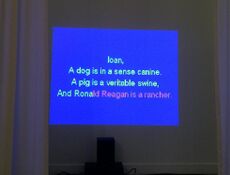Karaoke Bar: Difference between revisions
imported>Dotclub No edit summary |
imported>Dotclub No edit summary |
||
| Line 11: | Line 11: | ||
== Background == | == Background == | ||
* Discussed in {{RLink|LettersRK12}} | |||
[[File:Karaoke-Bar-photo2.jpg|thumb|upright|2015<ref>https://www.instagram.com/p/8ZlAmZOZnD/</ref>]] | [[File:Karaoke-Bar-photo2.jpg|thumb|upright|2015<ref>https://www.instagram.com/p/8ZlAmZOZnD/</ref>]] | ||
| Line 18: | Line 21: | ||
* [[An Old Man's Dream]] | * [[An Old Man's Dream]] | ||
* [[Hedges]] | * [[Hedges]] | ||
== Exhibitions == | == Exhibitions == | ||
Revision as of 13:01, 17 April 2023
| Karaoke Bar | |
|---|---|
 | |
| The Red Crayola with Art & Language | |
| Project | |
| Year | 2005 |
| Dimensions | |
| Materials | |
Background
- Discussed in
 Letters to the Red Crayola XII
Letters to the Red Crayola XII

Track list
Exhibitions
Reviews
Frieze
October 13, 2005[2]
Andrew Hunt
[...] The karaoke event took place between 5pm and 6pm each day, and tracks from the album Kangaroo? (1981), such as ‘A Portrait of V. I. Lenin in the Style of Jackson Pollock’ were available to sing along to. Another ‘gross and conspicuous error’ started to operate here, but this time the question appeared to be, what kind of historical displacement occurs when we the spectators, as blind performers, sing these 24-year-old lyrics? As before, we are complicit in our own bad performance and misreading of these essay-like texts and through a historical distance provide a necessary misinterpretation of Art & Language’s work. This is an essential component of the group’s practice, and if they represent a resistance to the category of Conceptual art, where a Duchampian model is ‘emptied of its transgressive potential and rendered congenial to the managers of interdisciplinarity’, then maybe this combination of music and politics is something to strive for. If the original intention of these irreconcilable forces was to ‘stress the grammar and the sense of the text to the point of oblivion’, then through the lens of history this partnership at least still appears alien and strange, but for different reasons. When current bands are mimicking the urgency of outfits from the late 1970s, minus the political awareness, and younger artists and curators are fixated on radical models but lacking any real substance, there’s another, unwitting form of historical karaoke operating. Perhaps what we need right now are more deliberately irresponsible yet ‘real’ collaborations of this sort.